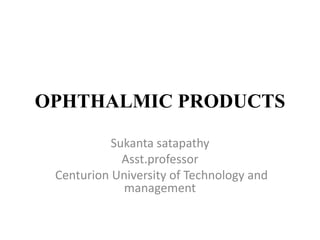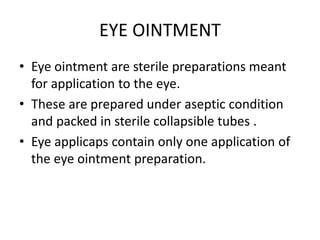Ophthalmics
- 1. OPHTHALMIC PRODUCTS Sukanta satapathy Asst.professor Centurion University of Technology and management
- 2. OPHTHALMIC PRODUCTS âĒ Ophthalmic products are sterile products meant for instillation into the eye. âĒ Ophthalmic products includes ïąEye-drops ïąEye-lotions ïąEye âointments ïąEye suspension ïąContact lens solution
- 10. CONTACT LENS SOLUTION âĒ CONTACT LENS SOLUTIONS âĒ a Contact lenses are usually made from polymethyl methacrylate which is a hard hydrophobic plastic. âĒ Nowadays, some softer hydrophilic lenses are also used. âĒ Hard Contact Lenses Wearers generally use two solutions. Âŧ 1-Wetting solution Âŧ 2- Storage solution âĒ 1. Wetting solution : âĒ It is used primarily for treating the lenses before insertion in to the eye. âĒ The formulation of contact lens solution may contain a ï wetting agent, ï thickening agent (cellulose derivative), ï antimicrobial agent (benzalkonium chloride, chlorohexidine), ï isotonicity adjusters (sodium chloride) .
- 11. 2. Storage solution It is used for overnight cleansing, soaking and storage. The contact lenses after its removal from the eye are cleaned with wetting solution and rinsed with purified water. Then they are stored in a storage solution to prevent dehydration. The formulation of storage solution contains a non-ionic surface active agent which will help in cleaning the contact lenses. It also contains preservatives to prevent the microbial growth.
- 12. EYE DROPS Eye drops are sterile aqueous or oily soultions or suspensions of drugs that are instilled into the eye with a dropper. They usually contains drugs like antiseptics,anaesthetics,anti- inflammatory properties. Essential characteristics of eye-drops âĒ It should be sterile. âĒ They should be iso-osmotic with lachrymal secretions. âĒ Should be free from foreign particles, fibres and filaments. âĒ They should have almost neutral pH. âĒ They should be preserved with a suitable bactericide. âĒ . They should remain stable during its storage.
- 13. Formulation of Eye-drops âĒ The eye drops are prepared in 4 stages. âĒ 1. Preparation of bactericidal and fungicidal vehicle : The aqueousus or oily vehicle is used in the preparation of eye-drops. âĒ The aqueous vehicle may support bacterial or fungal growth, so one of the following bactericide may be used to preserve the eye-drops:â â (i) Phenylmercuric nitrate/acetate 0.002% â ii) Benzalkonium chloride 0.01% â (iii) Chlorohexidine acetate 0.01% âĒ benzalkonium chloride is not suitable as preservative for eye-drops containing local anaesthetics. 2âĒ Preparation of solution of medicament(s) and adjuvants : âĒ rnedicament(s) are dissolved in the aqueous vehicle containing- antimicrobial agent. The adjuvants are also dissolved in this stage to form a stable preparation.
- 14. âĒ 3-Clarification âĒ The eye drops are clarified by passing the solution through membrane filter with pore size 0.8 Âĩm âĒ 4-Sterilisation âĒ The eye drops are sterilised by ïąAutoclaving, ïąFiltration through bacteria proof filter. ïąHeating with bactericide at 98-100 c for 30 minutes
- 15. âĒ Containers âĒ The eye drops packed in neutral glass containers of 4-8 ml . âĒ Plastic squeeze bottles with rigid plastic cap and polythene friction plug containing baffle that produces uniform drops. âĒ These are sterilised by gaseous sterilisation method. âĒ Labelling âĒ should be 'For External Use Onlyâ along with storage conditions to maintain full activity.
- 16. adjuvants used in the preparation of eye-drops : âĒ adjuvants used in the preparation of eye-drops : âĒ The following adjuvants are used in the preparation of eye drops:- âĒ 1. Thickening agent : The thickening agents, such as, methyl cellulose. carboxy methyl cellulose, polyvinyl alcohol, polyethylene glycol are used to increase the viscosity of eye-drops. It will also help to prolong the contact time of the drug in the eye. âĒ 2. Buffers : Buffers are added to adjust and maintain the pH of the eye-drops. âĒ The pH of the eye drop is adjusted to maintain chemical stability to reduce discomfort and to improve clinical response. âĒ The boric acid, sodium acid phosphate, sodium citrate are commonly used as buffers. âĒ 3. Anti-oxidants : They are added in several eye-drops to provide protection from oxidation. âĒ Sometimes the eye-drops are protected from oxidation by replacing the air in the container with an inert gas. âĒ Sodium metabisulphite (0.05 to 0.5%) and sodium thiosulphate (0.1 to 0.2%) are commonly used as antioxidants.
- 17. 4.Wetting agents âĒ These are used for penetration of eye drops into the cornea of the eye. âĒ Polysorbate 20 and polysorbate 80 5.Isotonicity adjustment substance âĒ Eye drops are made isotonic with lachrymal secretion with buffers. âĒ Examples of eye drop âĒ Atropine eye drop, physostigmine eye drop
- 18. EYE LOTION âĒ These are the sterile aqueous solutions used for washing of the eyes. âĒ The eye lotions are supplied in concentration form and diluted with warm water before use. âĒ They are usually applied with a clean eye-bath or sterilised fabric dressing and a large Amount of solution is allowed to flow quickly over the eye. âĒ Eye lotions should be isotonic and free from foreign particles to avoid irritation to the eye. âĒ They are required to be prepared fresh and should not be stored for more than two days as the lotion may get contaminated with micro-organisms. âĒ The drugs used for preparing eye solutions include sodium chloride, sodium bicarbonate, boric acid, borax or zinc sulphate.
- 19. Formulation of Eye Lotions âĒ Eye lotions are simple solution. âĒ They are iso osmotic with tears because they cause much greater dilution of the lachrymal fluid and, hence, are more likely to cause discomfort if not adjusted. âĒ The eye-lotions should be sterile. âĒ The eye lotions are sterilised by autoclaving or by passing through bacteria proof filters. âĒ Sodium chloride eye lotion and sodium bicarbonate eye lotion are commonly used to remove foreign substances from the eye.
- 20. EYE OINTMENT âĒ Eye ointment are sterile preparations meant for application to the eye. âĒ These are prepared under aseptic condition and packed in sterile collapsible tubes . âĒ Eye applicaps contain only one application of the eye ointment preparation.
- 21. FORMULATION OF EYE OINTMENT âĒ The ointment base selected for eye-ointment should be non-irritant to the eye. âĒ The ointment base should melt near to the body temperature to permit the diffusion of the drug in the eye. âĒ Yellow soft paraffin should be used instead of white soft paraffin .(because white soft paraffin contain bleaching agent may lead to irritation.
- 22. Container âĒ Eye ointment should be supplied in metal or plastic collapsible tubes. âĒ The tube must be fitted with a nozzle of suitable shape for application of ointment into the eyes without contamination. âĒ Eye ointment should be stored in a cool place.
- 23. EYE SUSPENSION âĒ The eye suspensions are prepared when the drug is insoluble in the desired vehicle or unstable in liquid form. âĒ Prepared for sustained action of the preparation. âĒ Essential characteristics- âĒ They should be sterile âĒ Isotonic âĒ Desired viscosity âĒ Fine particle size âĒ Suitably packed in a container.
- 24. References âĒ Pharmaceutics-2 R.M MEHTA vallabh prakasan.
- 25. THANK YOU
























